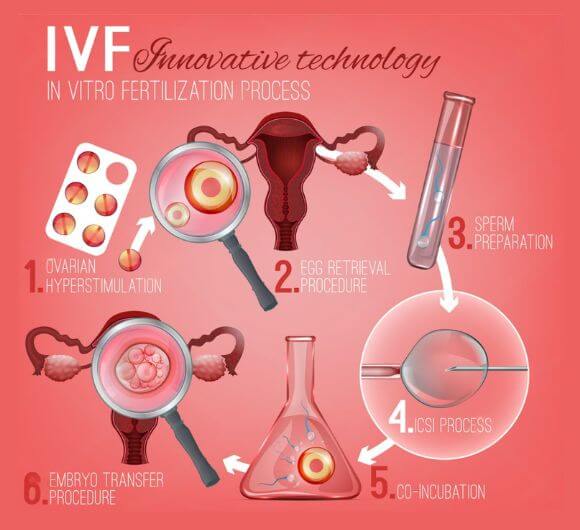IVF Treatment, or In Vitro Fertilization, is one of the wonders of modern medicine, helping thousands, potentially millions of people and couples achieve their dreams of parenthood. IVF treatment is at the core of all ART (assisted reproduction technology), providing hope to families seeking to overcome infertility and become the choice for same-sex couples and single individuals looking to start a family. This article thoroughly outlines the IVF treatment process, success rates, pros, cons, costs, and advancements, along with FAQs and myths, to inform and empower everyone considering IVF – it’s a life-changing journey.
What is IVF Treatment?
In Vitro Fertilization (IVF) The process of fertilizing an egg with sperm inside a lab and placing the embryo in the uterus to begin pregnancy. The term “in vitro” (Latin: in glass) is applied to the solution in the laboratory as a reference to glass test tubes (test tube babies). Since Louise Brown was born in 1978, the IVF procedure has come a long way and is now available to many as a common treatment to fix infertility problems.
The main purpose of the treatment is to help those who can’t naturally conceive because one partner has blocked or damaged fallopian tubes, low sperm count or ovulation disorders or where the actual cause of the problem is unexplained. It is also used for people who have genetic concerns, are in a same-sex marriage or are a single prospective parent using donated eggs, sperm or a surrogate. Process of IVF You need to know what is an IVF process when considering fertility options.
Also Read: How to Reduce Uterine Fibroids Naturally
The IVF Treatment Process

This process is quite comprehensive and includes many phases requiring medical intelligence, emotional strength and strategic planning. The following is an overview, explained step-by-step, of what happens in a regular course:
1. Initial Consultation and Testing
A comprehensive assessment is made of any patient before commencing their course of IVF therapy. These tests are blood tests, ultrasounds and sperm testing that measure hormone levels, how your ovaries are functioning and the quality of your sperm. The fertility doctor uses these results to design an individualized plan customized to you.
2. Ovarian Stimulation
In this treatment, the woman is given medication to encourage the ovary to produce 10 to 20 eggs rather than a single egg per cycle. Typically, during the normal menstrual cycle, a single egg is released, but in IVF, the intent is to have multiple eggs to increase the chances of fertilization. Medication to stimulate ovaries to make follicle-stimulating hormone (FSH) and luteinizing hormone (LH) is provided, and the progress of the patients is monitored using ultrasound and blood tests to monitor and assess the growth of follicles.
3. Egg Retrieval
After the eggs are mature, they are retrieved in a minor procedure called transvaginal ultrasound aspiration. This stage of IVF procedure is carried out under sedation, and a fine needle is inserted to retrieve the eggs from the ovarian follicles. It is a fast process with a duration of generally 20–30 minutes and individuals can usually go home the same day.
4. Sperm Collection and Fertilization
On the day of egg retrieval, a sperm sample is obtained from either the male partner or a sperm donor. In the laboratory, the sperm and eggs are combined for fertilization. In a standard treatment, the sperm and egg will fertilize on their own in a petri dish. In the case that, in addition to the egg using low sperm motility, only one sperm may be present for fertilization, intracytoplasmic sperm injection (ICSI) may be performed. ICSI directly injects the egg with a single sperm.
5. Embryo Culture
Following fertilization, embryos are growing in an incubator for 3–5 days. Embryologists examine the quality of embryos at this stage of treatment and choose the most viable embryos for transfer. Preimplantation genetic testing (PGT) can be done to check for genetic defects, particularly in patients with a history of genetic problems.
6. Embryo Transfer
The selected embryo(s) are then placed into the uterine cavity through a very fine plastic catheter. It is non-invasive, typically done without anesthesia, and it only takes a few minutes. How many embryos are transferred varies depending on age and the couple’s health history because transferring several increases the chances of multiple pregnancies. This phase of treatment is considered to dictate the ability to conceive.
7. Pregnancy Test
A blood test is usually performed about 10–14 days following the embryo transfer to confirm that pregnancy has occurred. A positive result means pregnancy monitoring begins, and a negative result could lead to consideration of further treatment cycles or other alternatives.
Success Rates
The success rate of the treatment differs due to factors like age, health and cause of infertility. The 2021 CDC data shows the percentage of cycles leading to live birth per IVF cycle in women under 35 as 40% to 50%, in women aged 35–40 as 20% to 30%, and in women over 40 as 10% to 15%. The following is a list of factors that influence success:
- Age: A young age will have the best quality eggs so better the treatment results.
- Lifestyle: Smoking, obesity, and stress all can decrease success rates, therefore, lifestyle modification is important during treatment.
- Clinic Expertise: The Level of Expertise of the Fertility Clinic and its Technology Clinic expertise is one of the most important causes in an IVF treatment success.
- Embryo Quality: Nothing increases your chance of IVF treatment working than good-quality embryos (often via PGT).
Though IVF provides hope it isn’t 100% successful, and you may need few cycles. Open and honest discussions with a fertility specialist can help patients to formulate realistic goals.
Also Read: Transform Your Life with Simple Daily Meditation Techniques
Benefits of IVF Therapy

IVF has revolutionized fertility treatment, providing several benefits for individuals and couples on their journey to parenthood:
- Clarifying Infertility: IVF can help with most forms of infertility, such as male factor infertility, endometriosis, and PCOS (Polycystic Ovarian Syndrome).
- Genetic Testing: Such kind of testing also allows couples to test their embryos and exclude or choose an embryo affected with genetic disease and also prevent the transfer of herediterial diseases in the process of the IVF procedure.
- Flexibility for Diverse Families: IVF works for same-sex couples, single parents, and couples using egg, sperm, or surrogate donors and can bring parenthood opportunities to those not otherwise able to conceive.
- Timing Control: With IVF process, individuals can freeze eggs or embryos for later use, which is beneficial for career-oriented individuals and those who wish to start a family at a later time.
- Potential for High Success: Although technology continues to evolve, treatment is more successful than many breakthrough fertility treatments.
Risks and Challenges of IVF Treatment
While IVF treatment is generally safe with few risks and complications that patients should be aware of:
- Physical Hazards: Ovarian stimulation may result in serious, life-threatening ovarian hyperstimulation syndrome (OHSS) involving bloating and pain. There is a small risk of bleeding or infection associated with egg collection.
- Emotional Cost: The emotional ups and downs of treatment and not being certain whether it will be successful might leave an expecting mother stressed, anxious or depressed. Therapy and self-help groups are common suggestions.
- Multiple Pregnancies: In transferring multiple embryos, the risk of giving birth to twins or triplets increases, which can result in complications such as preterm delivery.
- Cost: The IVF Treatment is a costly affair, and one cycle is generally priced at $12,000–$20,000 as per the USA and in most cases, insurance policies don’t cover these costs. Finances can be stretched by multiple cycles.
- Ethical Issues: Some people feel that it can be unethical to have the option to choose or terminate embryos in treatment, and thus, the process can be a matter of personal thought, contemplation as well as consultation from professionals.
Costs and Accessibility
IVF treatment Cost is also a big factor to consider. Stateside, one cycle typically costs $12,000–$15,000, excluding medications ($3,000–$5,000) and any additional procedures such as ICSI or PGT. Factors affecting cost include:
- Location: IVF treatment costs differ by country, where countries like India ($2,000–$4,000 per cycle) or Thailand have prices much lower than those in the U.S., but travel prices such as flight tickets need to be included.
- Clinic Reputation: Good-quality clinics may cost more for IVF because of advanced technology and expertise.
- Insurance Coverage: Some countries, such as in Europe, offers some form of partial or full coverage for IVF, while in the U.S., it depends upon the state and provider.
To make IVF more accessible, certain clinics provide financial plans, and companies offer IVF grants. It is essential to research and discuss costs upfront.
Emotional and Psychological Aspects
IVF Treatment emotional as well as physically, a journey that is. The anticipation of becoming pregnant is often met with unknowns, and the unexpected can throw you a curve ball. Coping strategies include:
- Seeking Support: Becoming part of IVF treatment support groups or seeing a fertility specialist can offer emotional strength.
- Being open: As a couple, when you are open to talking about the expectations and feelings, you will be better able to manage the stress.
- Self-Care: Activities including meditation, exercise and journaling can assist in managing anxiety.
- Realistic Expectations: By knowing IVF treatment could mean more than one cycle, one can prepare for the potential obstacles.
Advancements in IVF Treatment
IVF Treatment is becoming increasingly and rapidly progressive – with technology enabling better chances and experiences for all patients:
- Time-Lapse Photography: This technique looks in on the developing embryo in real time, helping embryo scientists (embryologists) to identify which embryos are healthiest for in vitro fertilization.
- AI: Using artificial intelligence to predict embryo viability and personalize IVF medication protocol, which in turn increases success rates.
- Cryopreservation: An innovation of cryopreservation for eggs, sperm and embryos will make the IVF Treatment more versatile while conserving fertility for the future.
- Non-Invasive Testing: Novel ways to evaluate the health of embryos without invasive biopsies are improving IVF results.
- Customized Medicines: Genetic profiling treatments and hormonal protocols make IVF treatment more precise and effective.
Ethical and Social Considerations
Ethical issues related to programmes of IVF treatment include the destiny of unwanted embryos, the use of donor gametes and accessibility differences. On a social level, it has expanded the options for building a family, but cultural taboos about infertility endure in certain communities. Open conversation and learning about IVF can demystify the treatment and clear any misunderstanding.
Preparing for IVF Treatment
Preparation is important to IVF success. Steps include:
- Select a clinic: Find out about high success rates, experienced staff, and transparent pricing at IVF Clinic.
- Lifestyle Modifications: Stop smoking, ensure a healthy weight and maintain a low-stress level to get better results.
- Financial Planning: Plan for more than one cycle and research other potential resources for insurance and/or financing.
- Forming a Support System: Find support from other couples who have experienced IVF treatment for direction and motivation.
Conclusion
IVF treatment is a life-saving option for individuals confronted with infertility or those who wish to pursue other avenues to parenthood. Knowledge of how it is performed, its advantages and disadvantages, risks, and costs can help the reader make educated decisions regarding their fertility. With technology continuing to get better and more affordable, IVF remains a beacon of hope and new beginnings. For couples weighing their options in IVF treatment, a reputable fertility specialist and solid support system are key to achieving their dream of having a family.
IVF treatment FAQs:
Q1. How much does it cost to get IVF in India?
A: The cost of IVF in India is generally between ₹1.2 lakh to ₹2.5 lakh per cycle. Prices will by clinic, city, and any additional treatments such as ICSI or PGT.
Q2. Is IVF treatment a painful process?
A: IVF is not typically painful, but certain aspects of the process, such as the injections and egg retrieval, can be uncomfortable. Patient is placed under sedation at the time of retrieval to reduce discomfort.
Q3. Can I conceive on my own after IVF?
A: Yes, Natural conception after IVF is indeed feasible, especially if the initial infertility problems are solved or evolve in the future. It depends on the individual’s health state.
Q4. What are the risks of IVF?
A: It has the same side effects as hormonal birth control: nausea, bloating, mood swings, cramps, and breast tenderness. Uncommon risks are Ovarian Hyperstimulation Syndrome (OHSS), infection or bleeding.
Q5. What are other options to IVF?
A: Yes, Other options are IUI (intrauterine insemination), fertility drugs, surgery if it is a reproductive problem, and donor sperm, eggs, or surrogacy in certain cases.
Q6. Does IVF raise the risk of birth defects?
A: The risk is higher than natural conception, but it remains small overall. The great majority of IVF babies are born healthy. Preimplantation genetic testing (PGT) is one way to screen for these problems.



